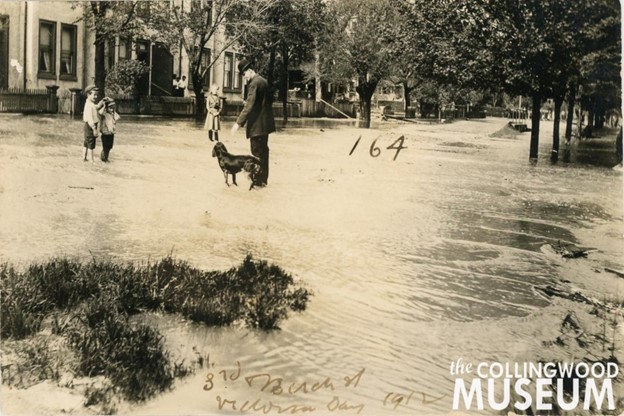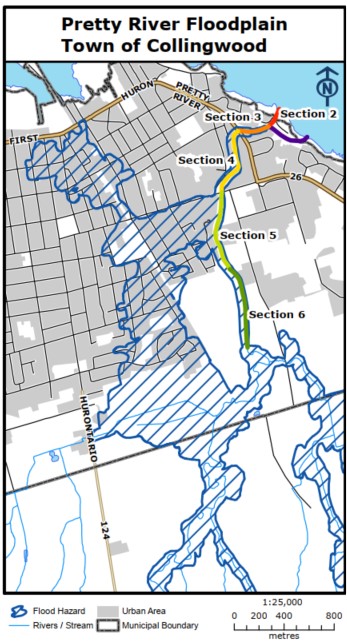
The Pretty River Dike was designed to help keep the downtown areas of Collingwood safe from flooding.
In order to make sure it functions properly, some of the vegetation growing along the banks of the dike must be removed from time to time.
History of Flooding in Collingwood
The Town of Collingwood was built on a shallow floodplain, making it prone to floods. Some of the most notable floods are the 1912 Victoria Day Flood and the 1942 St. Patricks’ Day Flood.

This is a view of Hume Street during the 1942 St. Patrick's Day flood. Photo contributed by the Collingwood Museum Huron Institute 2789; Collingwood Museum Collection X973.523.1, X973.524.1, X973.525.1

This photo was taken near the intersection of Third and Birch streets during the 1912 Victoria Day flood. Photo contributed by Collingwood Museum Huron Institute 148, 150, 164, 165; Collingwood Museum Collection X970.794.1, X969.594.1, X970.783.1, X970.789.1
The Pretty River
The Pretty River is one of four rivers that flow through the Town of Collingwood. It starts on the Niagara Escarpment, and flows through the Pretty River Valley. As it enters the town, it is contained by the Pretty River Dike as it flows to the Nottawasaga Bay.
The Pretty River Dike
In the 1970s, the Pretty River Dike was built to reduce the risk of flooding in the urban areas of Collingwood.
It is designed to contain the floodwaters from the Provincial Regulatory Storm Event — a storm so extreme that the likelihood of it happening is less than 1% chance in any given year. Although these events are rare, the risk to property damage and possible loss of life is high which is why the dike must be maintained.
This 2 km flood control structure starts at the southwest intersection of Peel Street and Lynden Street, passing the old CN Rail bridge (now the Siding Trail), then Hume Street and the Pretty River Parkway before ending at Oliver Crescent near the shore of Nottawasaga Bay.

This is what the dike looked like in the 1970s right after it was built. As time went on, vegetation began to grow on the dike. Taking a closer look, the dike is covered in 12” to 18” stone which protects the banks from the erosive forces of flowing water.
NVCA removed vegetation on the dike in 2006 and 2007. However, a recent study found that vegetation such as trees and large shrubs has continued to grow on the dike, slowing down the flow of flood waters and reducing the capacity of the corridor which in turn could lead to flood waters spilling over the dike during the Regulatory flood event.

The Pretty River Dike is divided into five sections.
Section 2: Bypass Weir/Culverts to Nottawasaga Bay
Section 3 Pretty River Parkway to Bypass Weir/Culverts
Section 4: Hume Street to Pretty River Parkway
Section 5: Barrie Collingwood Railway (Siding Trail) to Hume Street
Section 6: Start of Pretty River Dike to Barrie Collingwood Railway (Siding Trail)
River Trail
The recreational trail will continue to be available to residents and visitors. Most of the vegetation beside the trail will remain with the exception of trees that could impact the stability of the dike. After the vegetation removal, trail users will have a clearer view of the river.
Portions of the trail will be closed from time to time for maintenance activities for trail users’ safety.
Public Engagement
We encourage residents to reach out to ask questions about the Pretty River Dike Maintenance Project:
Nottawasaga Valley Conservation Authority
8195 8th Line, Utopia, ON L0M 1T0
705-424-1479
flood@nvca.on.ca
The Nottawasaga Valley Conservation Authority and the Town of Collingwood hosted two Q&A sessions in September and October, 2021
Did you miss the Q&A? Watch the recording here!
This project is funded by the Town of Collingwood.
